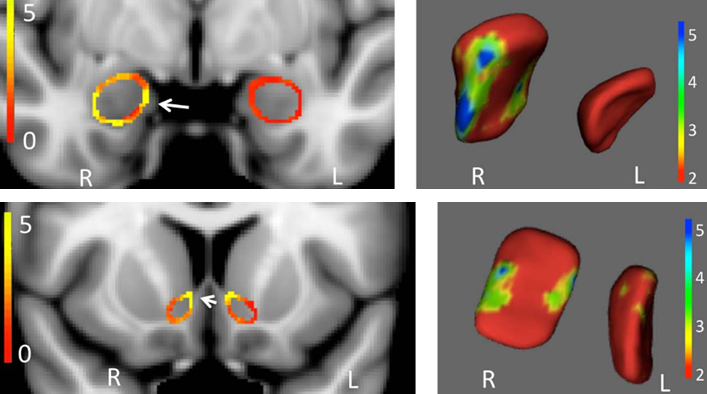Brain abnormalities associated with casual marijuana use
April 17, 2014
Young adults who used marijuana only recreationally showed significant abnormalities in two key brain regions that are important in emotion and motivation, scientists report.
The study was a collaboration between Northwestern Medicine and Massachusetts General Hospital/Harvard Medical School.
This is the first study to show casual use of marijuana is related to major brain changes. It showed the degree of brain abnormalities in these regions is directly related to the number of joints a person smoked per week. The more joints a person smoked, the more abnormal the shape, volume and density of the brain regions.
“This study raises a strong challenge to the idea that casual marijuana use isn’t associated with bad consequences,” said corresponding and co-senior study author Hans Breiter, MD. He is a professor of Psychiatry and Behavioral Sciences at Northwestern University Feinberg School of Medicine and a psychiatrist at Northwestern Memorial Hospital.
“Some of these people only used marijuana to get high once or twice a week,” Breiter said. “People think a little recreational use shouldn’t cause a problem if someone is doing OK with work or school. Our data directly says this is not the case.”
The study was published April 16 in the Journal of Neuroscience.
‘Abnormally altered’ brain regions
Scientists examined the nucleus accumbens and the amygdala — key regions for emotion and motivation, and associated with addiction — in the brains of casual marijuana users and non-users. Researchers analyzed three measures: volume, shape and density of gray matter (where most cells are located in brain tissue) to obtain a comprehensive view of how each region was affected.

In these MR brain images, the amygdala (top) and nucleus accumbens (bottom) are circled in red, and the yellow coloring indicates where the shapes of the structures are altered in recreational marijuana users (credit: Gilman et al./The Journal of Neuroscience 2014)
Both these regions in recreational pot users were abnormally altered for at least two of these structural measures. The degree of those alterations was directly related to how much marijuana the subjects used.

In these cross-sectional MR images, taken at different points within the brain, the red and yellow coloring indicates that gray matter density in the left nucleus accumbens — a region involved with reward and motivated behavior — is significantly greater in recreational marijuana users than in non-users (credit: Gilman et al./The Journal of Neuroscience 2014)
Of particular note, the nucleus acccumbens was abnormally large, and its alteration in size, shape and density was directly related to how many joints an individual smoked.
“One unique strength of this study is that we looked at the nucleus accumbens in three different ways to get a detailed and consistent picture of the problem,” said lead author Jodi Gilman, a researcher in the Massachusetts General Center for Addiction Medicine and an instructor in Psychology at Harvard Medical School. “It allows a more nuanced picture of the results.”
Examining the three different measures also was important because no single measure is the gold standard. Some abnormalities may be more detectable using one type of neuroimaging analysis method than another. Breiter said the three measures provide a multidimensional view when integrated together for evaluating the effects of marijuana on the brain.
“These are core, fundamental structures of the brain,” said co-senior study author Anne Blood, director of the Mood and Motor Control Laboratory at Massachusetts General and assistant professor of psychiatry at Harvard Medical School. “They form the basis for how you assess positive and negative features about things in the environment and make decisions about them.”
‘Users’ brains are adapting to low-level exposure to marijuana’
 Through different methods of neuroimaging, scientists examined the brains of young adults, ages 18 to 25, from Boston-area colleges; 20 who smoked marijuana and 20 who didn’t. Each group had nine males and 11 females. The users underwent a psychiatric interview to confirm they were not dependent on marijuana. They did not meet criteria for abuse of any other illegal drugs during their lifetime.
Through different methods of neuroimaging, scientists examined the brains of young adults, ages 18 to 25, from Boston-area colleges; 20 who smoked marijuana and 20 who didn’t. Each group had nine males and 11 females. The users underwent a psychiatric interview to confirm they were not dependent on marijuana. They did not meet criteria for abuse of any other illegal drugs during their lifetime.
The changes in brain structures indicate the marijuana users’ brains are adapting to low-level exposure to marijuana, the scientists said.
The study results fit with animal studies that show when rats are given tetrahydrocannabinol (THC) their brains rewire and form many new connections. THC is the mind-altering ingredient found in marijuana.
“It may be that we’re seeing a type of drug learning in the brain,” Gilman said. “We think when people are in the process of becoming addicted, their brains form these new connections.”
In animals, these new connections indicate the brain is adapting to the unnatural level of reward and stimulation from marijuana. These connections make other natural rewards less satisfying.
“Drugs of abuse can cause more dopamine release than natural rewards like food, sex and social interaction,” Gilman said. “In those you also get a burst of dopamine, but not as much as in many drugs of abuse. That is why drugs take on so much salience, and everything else loses its importance.”
The brain changes suggest that structural changes to the brain are an important early result of casual drug use, Breiter said.
“Further work, including longitudinal studies, is needed to determine if these findings can be linked to animal studies showing marijuana can be a gateway drug for stronger substances,” he noted. Gilman et al. state additional caveats in their Journal of Neuroscience paper:
This preliminary study has several caveats. First, the sample size does not provide power to examine complex interactions such as sex differences. Because this is a cross-sectional study, causation cannot be determined, although marijuana exposure parametrically correlated with structural differences, which suggests the possibility of causation. … Furthermore, this study did not include quantifiable marijuana metabolite levels, which would have provided further information about the amount of marijuana exposure. This measure could be incorporated into future studies as a complementary measure to detailed timeline follow-back measures of drug use. Finally, age of onset was collected for marijuana use only. Early exposure to alcohol may have also affected brain structure (although no participant met criteria for past alcohol abuse or dependence).
Because the study was retrospective, researchers did not know the THC content of the marijuana, which can range from 5 to 9 percent or even higher in the currently available drug. The THC content is much higher today than the marijuana during the 1960s and 1970s, which was often about 1 to 3 percent, Gilman said.
 Marijuana is the most commonly used illicit drug in the U.S. with an estimated 15.2 million users, the study reports, based on the National Survey on Drug Use and Health in 2008. The drug’s use is increasing among adolescents and young adults, partially due to society’s changing beliefs about cannabis use and its legal status.
Marijuana is the most commonly used illicit drug in the U.S. with an estimated 15.2 million users, the study reports, based on the National Survey on Drug Use and Health in 2008. The drug’s use is increasing among adolescents and young adults, partially due to society’s changing beliefs about cannabis use and its legal status.
A recent Northwestern study showed chronic use of marijuana was linked to brain abnormalities.
“With the findings of these two papers,” Breiter said, “I’ve developed a severe worry about whether we should be allowing anybody under age 30 to use pot unless they have a terminal illness and need it for pain.”
The research was supported by grants from the National Institute on Drug Abuse, and the National Institute of Neurological Disorders and Stroke, all of the National Institutes of Health. The Office of National Drug Control Policy and Northwestern Medicine’s Warren Wright Adolescent Center also supported the research.
UPDATE April 19, 2014: Title change: “link” changed to “associated with,” two magnetic resonance images added, and this text added:
Gilman et al. state additional caveats in their Journal of Neuroscience paper:
This preliminary study has several caveats. First, the sample size does not provide power to examine complex interactions such as sex differences. Because this is a cross-sectional study, causation cannot be determined, although marijuana exposure parametrically correlated with structural differences, which sug- gests the possibility of causation. … Furthermore, this study did not include quantifiable marijuana metabolite levels, which would have provided further information about the amount of marijuana exposure. This measure could be incorporated into future studies as a complementary measure to detailed timeline follow-back measures of drug use. Finally, age of onset was collected for marijuana use only. Early exposure to alcohol may have also affected brain structure (although no participant met criteria for past alcohol abuse or dependence).
